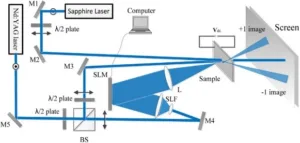Cuberox (Vancouver, WA and Prague, Czech Republic) is developing a unique device also called Cuberox. Physically, the device is a black cube with a 16 x 16 white LED display on each of its six sides. Inside the cube is a full-fledged computer. Each side of the cube can simultaneously run a stand-alone application making it unnecessary to switch between apps. All that is needed is to rotate the cube.
The control interface is represented as intuitive in that the cube can be controlled using simple gestures and manipulations. More specifically, it is possible to control the display presentation by changing the cube’s orientation and using motions such as swings, clicks, snaps and shakes. The API allows developers to assign their own gestures and actions.
Operation of the Cuberox is illustrated in a video appended at the end of this article.
The six identical faces of the cube create a monolithic,polycarbonate jacket. The jacket is not penetrated by any holes. This is made possible, in part, by the use of wireless data transmission technologies like Wi-Fi and Bluetooth and a wireless charger. As a result, the cube is claimed to be both dustproof and waterproof.
The wireless charging is accomplished in conjunction with a charging base. The charging base has embedded speakers and a multi-color smart back light, which could, for example, be used by applications to notify users of upcoming events. The company is in the process of integrating a microphone into a charging base intended to allow users to interact with the cube through voice commands. At this time, developers can use Google voice API for integrating voice controls into their custom applications. At a later time, Julius or CMU Sphinx may be used as a voice recognition system.
The company suggests a variety of possible uses for the Cuberox. These include:
Participating in multiplayer games via Wi-Fi.
Checking information from any point of the room.
Connecting google calendar to get notified of upcoming events.
Getting tweets.
A smart alarm or a night lamp.
Connecting to a smartphone and displaying information on all of the cube’s 6 screens.
Technical specifications for the Cuberox include the following:
CPU: iMX233 ARM926J processor @ 454Mhz
RAM: 64 MB
ROM: 4GB SD-card
Battery capacity: 7800mAh
Controls: accelerometer and gyroscope
Arch Linux ARM (3.16 kernel)
Node.js support with Cuberox API. In addition, the JavaScript language is used.
Size: 100 x 100 x 100 mm
MicroUSB power
To fund product development, the company is currently engaged in a Kickstarter campaign. At the time this article is written, 272 backers have pledged $62,273 of a $150,000 goal. The campaign is scheduled to close on March 29, 2015. The status of the project is represented as follows:
The first round of prototyping is complete having produced a working wireless cube.
An operating system has been set up.
Completed testing of drivers for screens.
Checked working accelerometer and other hardware parts.
Created some apps to test and prepared alpha version of API.
Must still implement a wireless charger.
Must still implement control speakers and LEDs on the charging station.
Must still develop software for the accelerometer and gyroscope.
The company is also in the process of creating the so-called Cuberia store, an app store for Cuberox.
The Cuberox seems like a really clever product concept. It will be seen if it achieves the funding needed to go on and becomes a reality. – Arthur Berman

